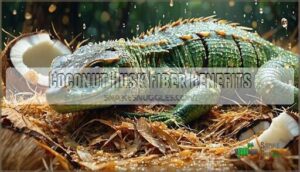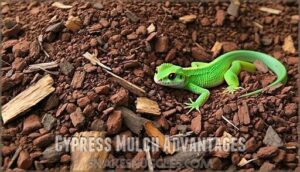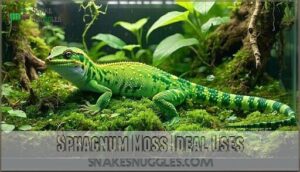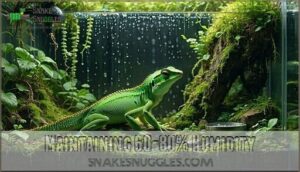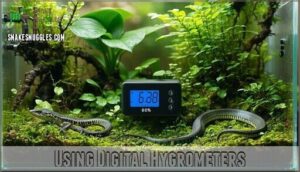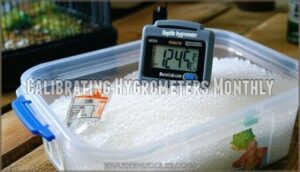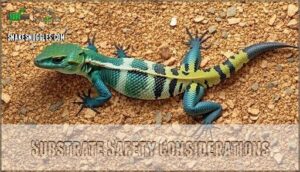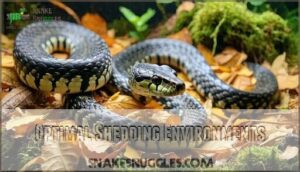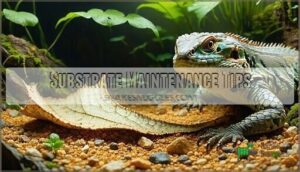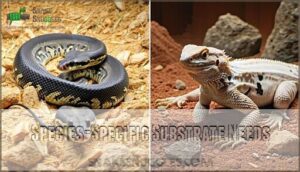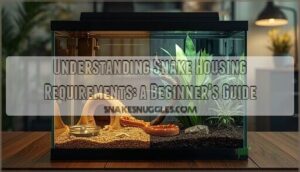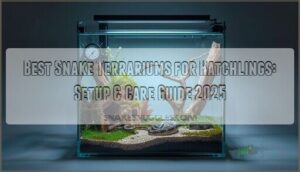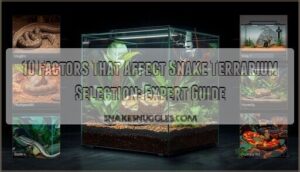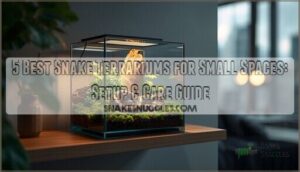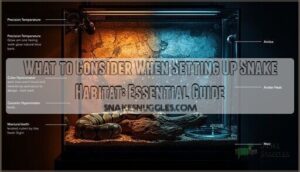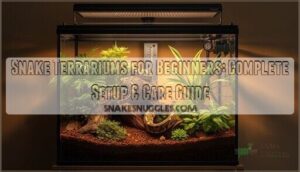This site is supported by our readers. We may earn a commission, at no cost to you, if you purchase through links.
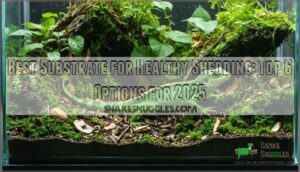
Coconut husk fiber tops the list—it holds moisture without getting soggy and provides perfect rubbing texture. Cypress mulch offers natural humidity control, while sphagnum moss creates humid microclimates your reptile craves.
Paper towels work for quarantine situations, though they lack the natural feel most reptiles prefer. Avoid cedar and pine shavings, which contain harmful oils.
The secret isn’t just picking any substrate—it’s understanding how different materials interact with your specific species’ needs and your enclosure’s setup, which is the key to a healthy environment.
Table Of Contents
- Key Takeaways
- Substrate Types Compared
- Humidity Control Methods
- Substrate Safety Considerations
- Top 6 Substrates for Shedding
- Optimal Shedding Environments
- Substrate Maintenance Tips
- Species-Specific Substrate Needs
- Frequently Asked Questions (FAQs)
- Can you use a ball python substrate for shedding?
- How do I choose a suitable substrate?
- What is a good substrate for ball pythons?
- Is coconut a good substrate for a Bally?
- What is the easiest substrate to maintain?
- What’s the best substrate for corn snakes?
- What is the best substrate for royal pythons?
- How often should substrate be completely replaced?
- Can mixing different substrates improve shedding conditions?
- What substrate depth works best for burrowing?
- Conclusion
Key Takeaways
- Choose moisture-retaining substrates like coconut husk fiber, cypress mulch, or sphagnum moss to maintain the 60-80% humidity your reptile needs for successful shedding cycles.
- Avoid toxic materials such as cedar and pine shavings, which contain harmful oils that can cause respiratory problems and skin irritation during vulnerable shedding periods.
- Create humidity gradients by combining different substrates and using digital hygrometers to monitor moisture levels, ensuring your pet can find the perfect microclimate for comfortable shedding.
- Maintain proper substrate hygiene through daily spot cleaning and monthly complete replacements to prevent bacterial growth and mold that can compromise your reptile’s health during shedding.
Substrate Types Compared
You’ll find three primary substrate types that excel at creating the perfect shedding environment for your reptile.
Each option offers unique benefits for moisture retention and humidity control, making your choice dependent on your specific setup and maintenance preferences.
The selection of substrate is crucial as it directly affects the humidity control and overall well-being of your reptile.
Coconut Husk Fiber Benefits
You’ll find coconut husk fiber excels at moisture retention, creating perfect humidity for shedding cycles.
Coconut husk fiber creates the perfect moisture sanctuary for smooth, successful reptile shedding cycles.
This coconut fiber substrate offers dust-free qualities that won’t irritate your reptile’s respiratory system.
Its antimicrobial properties naturally fight bacteria while providing safe ingestion protection.
The substrate’s odor neutralization keeps enclosures fresh, making coconut husk an ideal choice for reptile substrate shedding success.
Cypress Mulch Advantages
Cypress mulch offers exceptional humidity control while staying lightweight and easy to manage.
This substrate maintains consistent moisture levels without becoming waterlogged, making it perfect for reptiles who need steady humidity during shedding cycles.
Here’s why cypress mulch stands out:
- Humidity retention keeps your pet’s skin properly moisturized
- Mold resistance prevents harmful bacterial growth in the enclosure
- Lightweight nature makes substrate changes effortless for you
- Cleaning ease allows quick spot-cleaning of waste materials
- Splinter-free composition protects delicate reptile skin from injury
For alternatives, consider substrates with better moisture retention.
Sphagnum Moss Ideal Uses
Sphagnum moss transforms your reptile’s environment into a moisture sanctuary.
You’ll find it’s perfect for humid hide boxes, where your pet can retreat during shedding cycles for ideal humidity retention.
| Application | Humidity Level | Maintenance |
|---|---|---|
| Humid hide | 80-90% | Replace weekly |
| Egg incubation | 85-95% | Monitor daily |
| Wound care | 70-80% | Change as needed |
| Terrarium drainage | Variable | Monthly refresh |
| Plant propagation | 60-70% | Mist regularly |
This versatile sphagnum moss substrate excels in creating microclimates that support healthy shedding while serving multiple terrarium functions.
Humidity Control Methods
You’ll need accurate humidity readings to create the perfect shedding environment for your reptile.
Digital hygrometers provide precise measurements, but they require monthly calibration using the salt test method to guarantee reliable 60-80% humidity levels, ensuring a reliable environment.
Maintaining 60-80% Humidity
You’ll need to maintain humidity levels between 60-80% for ideal shedding success, creating a humidity gradient across your reptile’s enclosure.
Regular misting frequency and proper moisture retention prevent mold while supporting healthy skin renewal.
Monitor humidity control carefully—too little causes stuck shed, while excessive moisture breeds bacteria.
Quality water and consistent humidity monitoring guarantee your pet’s shedding process stays smooth and stress-free.
Using Digital Hygrometers
You’ll want to place your hygrometer at snake level for accurate readings that reflect your pet’s actual environment.
Digital hygrometers provide precise humidity monitoring, helping you maintain ideal humidity levels between 60-80%.
Choose reliable brands with clear displays and consider multiple units for thorough humidity control throughout the enclosure.
Reptile owners can find hygrometers for sale online for accurate readings.
Calibrating Hygrometers Monthly
Your hygrometer’s accuracy directly impacts successful humidity regulation for proper shedding.
Perform the salt test monthly using calibration tools to verify readings within 2-3% accuracy.
Different hygrometer types require specific calibration methods, but consistent calibration frequency guarantees reliable humidity control methods that support healthy shedding humidity levels for your reptiles.
Many pet owners source calibration product options online for proper calibration and to ensure healthy shedding.
Substrate Safety Considerations
You’ll want to choose substrates carefully since some options can harm your reptile’s health during vulnerable shedding periods.
Avoiding toxic materials like cedar and pine while selecting dust-free, ingestion-safe alternatives protects your pet’s respiratory system and prevents dangerous blockages.
This ensures a safe environment for your reptile, and by doing so, you protect your pet’s health.
Toxic Substrate Avoidance
You’ll want to steer clear of certain toxic substrates that can seriously harm your reptile’s health.
Cedar and pine shavings release harmful oils causing respiratory problems and skin irritation. Sand poses impaction risks when ingested, while abrasive gravel damages delicate skin.
Reptile carpet traps bacteria and can snag scales. These substrate safety mistakes lead to shedding problems in reptiles and compromise their respiratory health overall.
However, recent studies suggest that substrate impaction is often linked to poor husbandry.
Dust-Free Substrate Options
For ideal respiratory health, choose substrates with minimal particle size to reduce allergen concerns.
Coconut husk fiber and compressed coconut chips offer dustfree shedding aid for reptiles with respiratory sensitivity.
Brown kraft paper provides completely dustfree environments, supporting shedding success without compromising cleaning frequency.
These substrate alternatives prevent shedding problems in reptiles while maintaining proper humidity levels.
Ingestion Risk Prevention
Beyond dust concerns, you’ll want to protect your reptile from accidentally eating their bedding during meals.
Smart food placement makes all the difference in preventing ingestion risk and supporting healthy shedding cycles.
Here’s your three-step safety strategy:
- Separate Feeding areas away from substrate-heavy zones
- Elevated Bowls that lift food above substrate particles
- Feeding Tongs for precise food placement and control
Choose appropriate substrate size – avoid tiny particles that stick to prey items.
This simple substrate selection change prevents shedding problems reptiles face when dealing with digestive blockages.
Top 6 Substrates for Shedding
When your reptile starts the shedding process, choosing the right substrate becomes essential for their health and comfort.
The following six substrates stand out for their moisture retention, safety profile, and ability to create the ideal humidity levels your pet needs for a successful shed, which includes considering their safety profile.
1. Bioactive Tropical Substrate for Terrariums
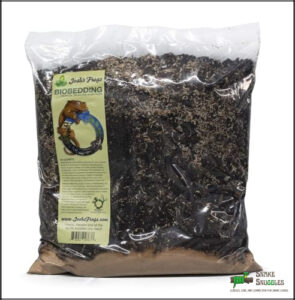
Why settle for basic substrates when bioactive tropical substrate transforms your terrarium into a self-sustaining ecosystem?
This premium blend of coconut fiber, sphagnum moss, and orchid bark creates perfect humidity levels for healthy shedding.
The substrate maintains 60-80% humidity naturally while beneficial microorganisms break down waste, eliminating frequent changes.
You’ll love watching springtails and isopods create a thriving cleanup crew that keeps your pet’s environment fresh for months, thanks to the self-sustaining ecosystem.
Best For: Reptile and amphibian enthusiasts who want to create naturalistic, low-maintenance terrariums with live plants and beneficial microfauna.
- Eliminates need for frequent substrate changes (lasts months to years) through self-sustaining bioactive ecosystem
- Maintains optimal 60-80% humidity levels naturally, promoting healthy shedding and reducing dysecdysis risk
- Creates thriving cleanup crew of springtails and isopods that break down waste and maintain freshness
- May introduce unwanted hitchhikers like snails or glass worms that some users find undesirable
- Not suitable for enclosures at risk of mites or pests due to bioactive nature requiring established, healthy pets
- Requires monitoring for uneven substrate levels from burrowing microfauna that can affect decorative stability
2. Zoo Med Forest Floor Bedding
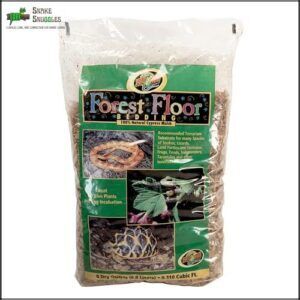
Forest Floor Bedding delivers impressive moisture retention, holding up to 60% more water than standard wood shavings.
Exceptional moisture retention creates the perfect humidity sanctuary for smooth, stress-free shedding cycles.
This cypress mulch substrate maintains humidity levels between 65-80% for up to seven days after misting, creating ideal conditions for successful shedding.
You’ll appreciate its dust-free composition and UV-sterilized processing that prevents mold growth.
The natural cypress material resists rapid drying while forming beneficial microclimates when moistened, and professional herpetoculturists frequently recommend this substrate for ball pythons, corn snakes, and tropical species prone to stuck shed issues, due to its ability to create ideal conditions.
Best For: Reptile and amphibian owners seeking superior humidity retention for healthy shedding, particularly those with ball pythons, corn snakes, and tropical species.
- Retains up to 60% more moisture than standard wood shavings, maintaining 65-80% humidity for up to seven days after misting
- UV-sterilized and dust-free composition (less than 2% dust) prevents mold growth and respiratory irritation
- Natural cypress material creates beneficial microclimates and supports successful shedding cycles in humidity-dependent species
- Higher price point compared to basic substrates, especially for large enclosures requiring frequent replacements
- Requires regular misting maintenance and full substrate replacement every 30-45 days for optimal performance
- Occasional large pieces may need manual removal to prevent potential injury to smaller reptiles
3. Zoo Med Eco Earth Substrate
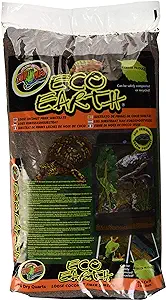
When you’re looking for a substrate that’s both eco-friendly and effective, Zoo Med Eco Earth delivers excellent results.
Made from compressed coconut fiber, this substrate expands naturally when moistened, creating a soft burrowing environment that maintains consistent humidity levels.
It’s dust-free and chemical-free, making it safe for sensitive reptiles.
You’ll appreciate how it holds moisture without becoming soggy, supporting healthy shedding cycles while preventing respiratory issues that dusty alternatives can cause.
Best For: Reptile and amphibian owners seeking an eco-friendly substrate that maintains proper humidity levels for tropical species, burrowing animals, and pets requiring consistent moisture for healthy shedding.
- Can cause substrate to stick to prey items during feeding, requiring external feeding solutions for some reptiles
- Not suitable for desert species as it may create excessive humidity leading to potential fungal growth issues
- Comes in non-resealable packaging that requires additional storage solutions like taping the bag closed
- Natural coconut fiber material that’s chemical-free, dust-free, and safe for sensitive reptiles while supporting healthy shedding cycles
- Excellent moisture retention and humidity control, expanding 2-3x when moistened to create ideal microclimates for tropical species
- Eco-friendly and sustainable substrate made from renewable coconut husks that’s compostable after use
4. Fluker’s Repta Bark Natural Bedding
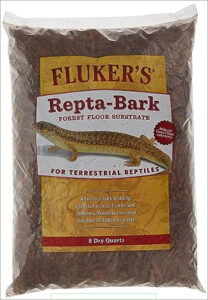
With 100% natural fir bark, Fluker’s Repta Bark delivers exceptional humidity control for healthy shedding.
You’ll appreciate its dust-free formula that won’t irritate your reptile’s respiratory system.
The bark chunks resist quick breakdown while maintaining ideal 60-80% humidity levels.
It’s processed at high temperatures to eliminate pests and pathogens, making it safe for sensitive species like ball pythons.
This substrate encourages natural burrowing behaviors that support the shedding process, providing exceptional humidity control and a dust-free environment.
Best For: Reptile owners with high-humidity species like ball pythons, tortoises, and bearded dragons who need reliable substrate for healthy shedding cycles.
- Maintains optimal 60-80% humidity levels while resisting mold and quick breakdown
- Dust-free formula processed at high temperatures to eliminate pests and pathogens
- Encourages natural burrowing behaviors and provides long-term substrate stability
- Requires daily spot cleaning and monthly full replacement for optimal health outcomes
- Small bark size may require larger quantities to adequately fill enclosures
- Some batches may contain dust or unusable portions requiring pre-cleaning before use
5. Brown Kraft Packing Paper Roll
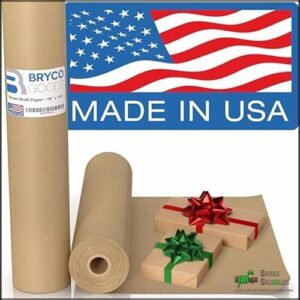
Paper substrates offer surprising advantages for reptile shedding cycles.
Brown kraft packing paper creates a smooth, dust-free surface that won’t snag delicate shed skin like rougher materials might.
You’ll find it’s incredibly cost-effective at under ten cents per square foot, making frequent replacements budget-friendly.
The non-toxic, recyclable material eliminates chemical concerns while providing excellent visibility for monitoring your pet’s health.
However, it lacks humidity retention and burrowing opportunities that many reptiles crave during vulnerable shedding periods, making it a less ideal choice in terms of providing a complete environment for shedding cycles.
Best For: Reptile keepers seeking an affordable, hygienic substrate solution for species that don’t require burrowing or high humidity environments.
- Extremely cost-effective at under $0.10 per square foot with easy spot-cleaning and weekly full replacements
- Smooth, non-toxic surface prevents shedding complications and provides excellent visibility for health monitoring
- Eliminates parasite and bacterial buildup risks compared to organic substrates, making it ideal for quarantine setups
- Lacks humidity retention and burrowing opportunities that many reptiles need during shedding cycles
- Provides minimal insulation requiring careful ambient heating monitoring
- Tears easily under sharp claws and offers plain aesthetics compared to naturalistic substrate options
6. RediChip Reptile Coconut Chip Bedding
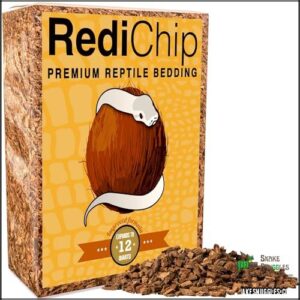
Since coconut chips hold up to 2.5 times their weight in water, RediChip creates the perfect humidity buffer for your reptile’s shedding needs.
You’ll appreciate how this dust-free substrate maintains stable moisture for over 24 hours after misting, reducing your daily maintenance routine.
The larger chip size prevents accidental ingestion while providing gentle abrasion that helps remove stubborn shed skin, which is crucial for avoiding respiratory health risks, as explained in this link: respiratory health risks.
With 90% of keepers reporting smoother shed cycles, this sustainable option outlasts traditional substrates by weeks.
Best For: Snake owners, tropical reptile keepers, and anyone seeking a sustainable, dust-free substrate that maintains consistent humidity for optimal shedding cycles.
- Higher upfront cost compared to basic substrate options, though long-term value improves due to extended lifespan
- May require mixing with other substrates for larger enclosures (55 gallons) to achieve adequate coverage depth
- Needs regular hydration and monthly replacement to maintain optimal structure and prevent gradual breakdown
- Holds up to 2.5 times its weight in water, maintaining stable moisture for 24 hours with minimal daily maintenance
- Dust-free and heat-treated substrate reduces respiratory irritation and pathogen risk compared to untreated alternatives
- Larger chip size prevents accidental ingestion while providing gentle abrasion that aids natural shedding processes
Optimal Shedding Environments
You’ll need to create the perfect environment where your snake can shed successfully without stress or complications.
The right combination of substrate depth, humidity control, and temperature gradients makes all the difference between a clean shed and potential health problems.
Creating Microclimates
You’ll create perfect humidity gradients when you set up distinct temperature zones throughout your enclosure.
Each microclimate offers different moisture levels—cooler areas hold more humidity while warmer spots stay drier.
This setup mimics your reptile’s natural habitat, encouraging healthy burrowing behavior in layered substrates.
Regular misting can help, but be cautious of potential mold growth.
Your snake can choose its ideal shedding spot within these naturalistic enclosures, which provide a suitable environment for healthy reptile care and promote ideal shedding conditions.
Layered Substrate Benefits
Layered reptile substrate creates humidity gradients that mirror your pet’s natural habitat.
You’ll build different moisture zones by combining materials – placing damp sphagnum moss near water bowls and drier cypress mulch toward basking areas.
This naturalistic setup encourages natural burrowing behavior while providing enrichment opportunities that help your reptile feel secure during vulnerable shedding periods.
Ambient Temperature Control
Temperature control goes beyond layered substrates – it’s what makes your reptile’s shedding microclimate work perfectly.
You’ll need a basking spot at 88-92°F with temperature gradients throughout the enclosure.
Thermostat control prevents dangerous overheating while maintaining proper humidity reptiles require.
Night temperatures can drop 5-8°F safely, and heat sources should create ideal shedding environments without drying out your carefully crafted shedding conditions.
Substrate Maintenance Tips
Proper substrate maintenance keeps your reptile healthy and creates the ideal conditions for successful shedding cycles.
You’ll need to establish a consistent cleaning routine that balances hygiene with humidity retention to prevent bacterial growth while supporting your pet’s natural shedding process, which is crucial for maintaining the overall health of your reptile.
Daily Spot Cleaning
Maintaining clean substrate starts with removing waste promptly—it’s like keeping your kitchen tidy while cooking.
Daily spot cleaning prevents ammonia buildup and odor control issues that can stress your reptile during vulnerable shedding periods.
Your hygiene practices directly impact substrate maintenance success.
- Remove feces and soiled bedding immediately using feeding tongs
- Check water bowls for contamination and refresh as needed
- Monitor high-humidity areas where bacteria prevention is critical
- Document any unusual odors or discoloration in your shedding substrate to ensure odor control.
Monthly Substrate Replacement
Replacing your shedding substrate completely each month prevents mold prevention issues and bacteria buildup that compromise your reptile’s health.
This complete change strategy guarantees the best odor control while maintaining the substrate’s moisture-retention properties.
Use reptile-safe products during changeovers to eliminate harmful microorganisms that daily spot cleaning can’t reach.
Proper substrate selection, like using coconut fiber options, also aids in moisture control and is a key part of reptile health maintenance.
Regular Misting and Monitoring
You’ll need to monitor humidity spikes carefully after misting to prevent shedding problems reptiles experience from oversaturated substrates.
Check your hygrometer placement at snake level twice daily, focusing on water quality by using distilled water for spot misting.
Watch for shedding observation clues like cloudy eyes, then adjust misting frequency accordingly to support healthy reptile shedding without creating soggy conditions that cause shedding issues.
Consider using a reptile digital hygrometer to maintain ideal humidity levels.
Species-Specific Substrate Needs
You’ll need different substrates based on your reptile’s natural habitat and specific needs.
Ball pythons require moisture-retaining substrates like coconut fiber, while desert species thrive with drier options like cypress mulch.
Ball Python Habitat Requirements
Ball python substrate selection directly impacts their shedding success.
Your snake needs specific conditions that mirror their African grassland origins, where they’d burrow into loose, humid earth.
- Natural Burrowing: Coconut husk or cypress mulch allows tunneling behaviors that promote healthy skin turnover
- Temperature Gradients: Substrate depth of 3-4 inches creates thermal layers from 78-92°F
- Humidity Levels: Moisture-retentive substrates maintain 60-80% humidity for proper shedding
- Enclosure Size: Adequate substrate coverage prevents shedding problems reptiles commonly face
- Hiding Places: Sphagnum moss hide boxes boost local humidity during shed cycles
Tropical Reptile Substrate Recommendations
Your tropical reptiles’ enclosures thrive with coconut fiber and sphagnum moss combinations that create essential humidity gradients.
These naturalistic bioactive substrates support burrowing behaviors while preventing mold through proper drainage.
Substrate variety enhances ideal shedding environments—mix different textures for cost effectiveness. Your reptile enclosure substrate should maintain 70-80% humidity levels consistently for healthy skin renewal.
Desert Reptile Substrate Considerations
While tropical species need high humidity, desert reptiles like bearded dragons and leopard geckos require arid substrates with low humidity (20-40%).
Choose washed play sand or clay-based mixes that support burrowing needs and heat retention.
These naturalistic setups prevent respiratory issues while improving reptile shed cycles, and it is crucial to avoid coconut-based substrates that trap moisture and cause skin infections in desert species.
Frequently Asked Questions (FAQs)
Can you use a ball python substrate for shedding?
Yes, you can absolutely use ball python substrate for healthy shedding.
Coconut fiber, cypress mulch, and sphagnum moss are excellent choices that maintain the 60-80% humidity levels your snake needs for successful shedding.
How do I choose a suitable substrate?
Consider your snake’s life-or-death shedding needs first.
Choose substrates with excellent moisture retention like coconut fiber or cypress mulch.
Prioritize dust-free, burrowable options that maintain 60-80% humidity while avoiding toxic cedar or pine.
What is a good substrate for ball pythons?
For ball pythons, you’ll want coconut husk fiber, cypress mulch, or bioactive substrates.
These options retain moisture well, support burrowing behavior, and maintain the 60-80% humidity levels your snake needs for healthy shedding.
Is coconut a good substrate for a Bally?
Coconut substrate excels for ball pythons because it retains moisture beautifully, helping maintain that essential 60-80% humidity for perfect sheds. It’s naturally antimicrobial and allows burrowing too.
What is the easiest substrate to maintain?
Like a magician’s effortless trick, paper substrate wins the maintenance game.
You’ll simply spot clean daily and replace weekly – no mold worries, no humidity battles.
It’s absorbent, cheap, and recyclable, making your life easier.
What’s the best substrate for corn snakes?
Aspen shavings work best for corn snakes—they’re dust-free, allow natural burrowing, absorb moisture well, and resist mold. You can also use cypress mulch or paper towels for easy maintenance.
What is the best substrate for royal pythons?
Coincidentally, you’re asking about royal pythons (ball pythons) right after corn snakes.
For healthy shedding, coconut fiber or cypress mulch work best.
They retain moisture perfectly, maintain 60-80% humidity, and allow natural burrowing behavior.
How often should substrate be completely replaced?
You’ll want to completely replace your ball python’s substrate every 3-4 weeks, or monthly during heavy shedding seasons.
However, daily spot cleaning removes waste and prevents bacteria buildup between full changes.
Can mixing different substrates improve shedding conditions?
Yes, you can mix substrates to create ideal shedding conditions.
Combine coconut fiber with cypress mulch for excellent humidity retention and easy cleaning.
Layer sphagnum moss in humid hides during shedding cycles for targeted moisture support.
What substrate depth works best for burrowing?
Like a snake creating its perfect underground sanctuary, you’ll want 3-4 inches of substrate depth.
This allows your ball python to burrow naturally while maintaining proper humidity gradients for healthy shedding.
Conclusion
Choosing the best substrate for healthy shedding transforms your reptile’s life from miserable molt struggles to effortless skin renewal.
You’ve learned that coconut husk fiber, cypress mulch, and sphagnum moss lead the pack for moisture retention and texture.
Remember to maintain proper humidity levels, avoid toxic materials like cedar, and match substrate choices to your species’ specific needs.
Monitor regularly and spot-clean daily for ideal results.
- https://www.familyreptiles.com/post/what-substrate-or-bedding-is-safe-and-best-to-use-for-my-reptile-s-habitat
- https://www.anapsid.org/substrates2.html
- https://talis-us.com/blogs/blog-47/top-choices-for-best-substrates-for-reptiles-explained
- https://www.reddit.com/r/reptiles/comments/1ali5yo/did_i_mess_up/
- https://www.thebiodude.com/blogs/reptile-and-amphibian-husbandry-basics/does-substrates-cause-impaction-in-reptiles

